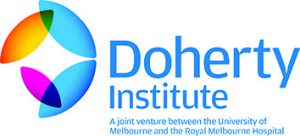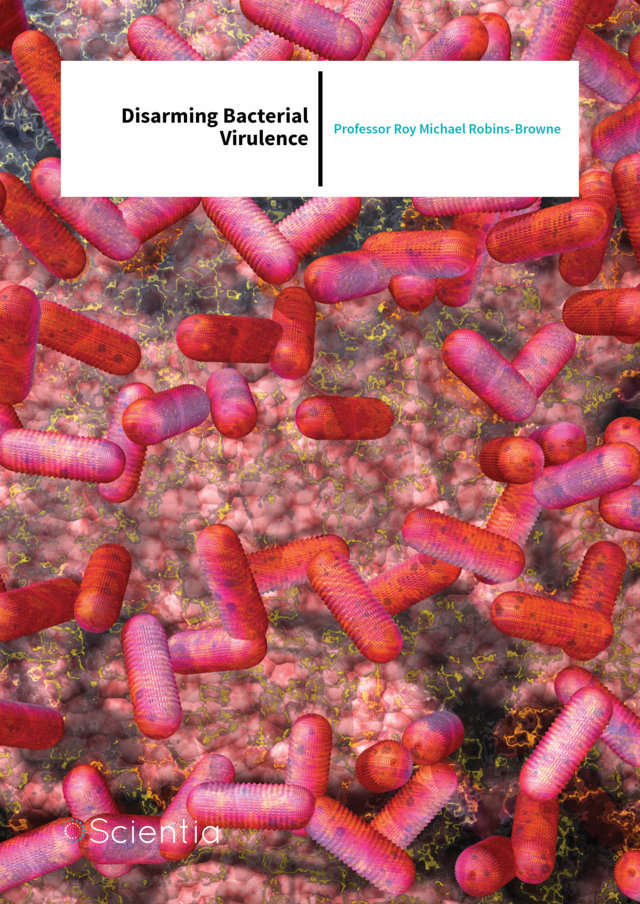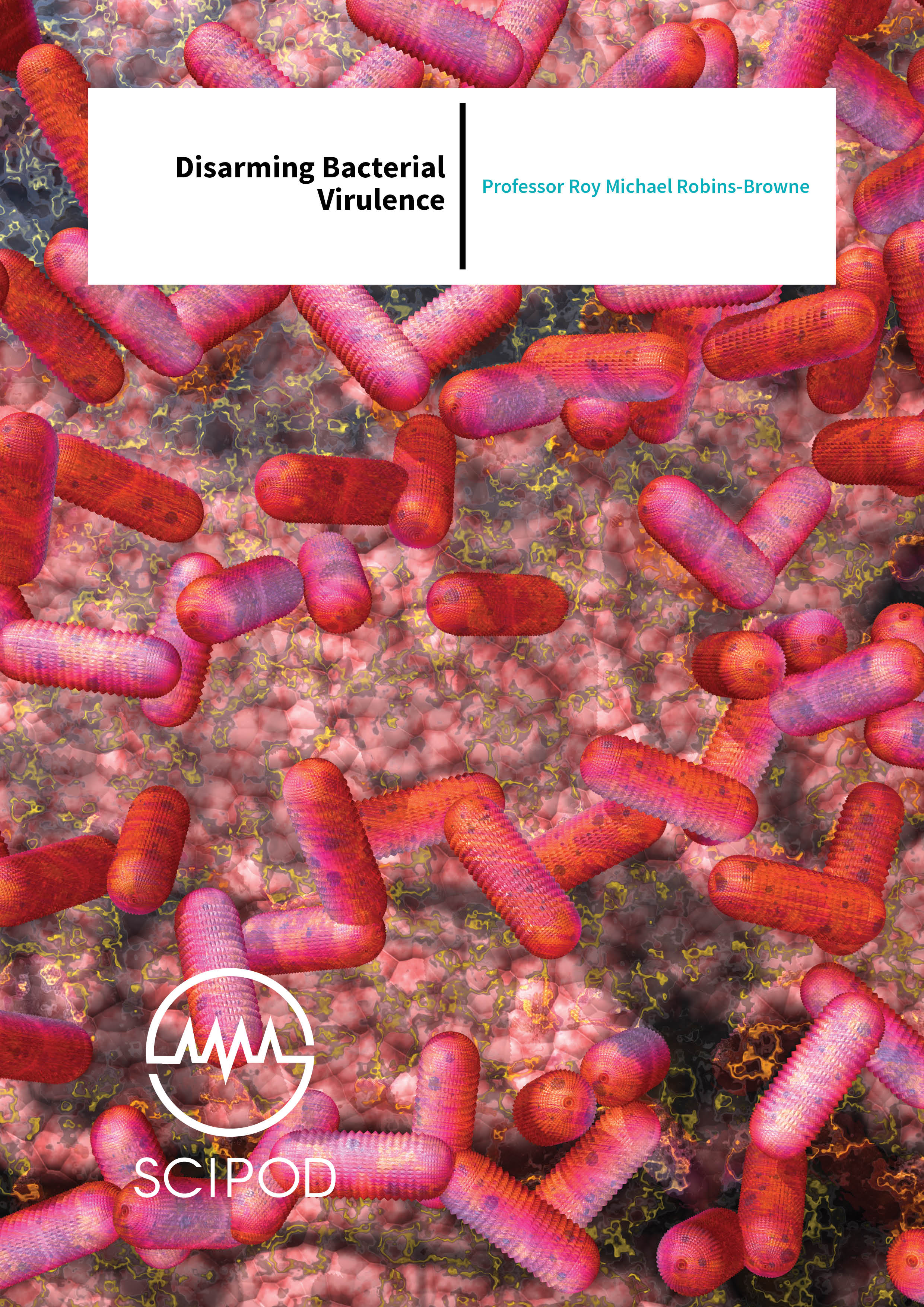Professor Roy Robins-Browne – Disarming Bacterial Virulence
With antibiotic resistance rapidly emerging among many important bacterial pathogens, it is imperative that new classes of antimicrobials are developed. Professor Roy Robins-Browne and his team at The University of Melbourne are taking a novel approach to antimicrobial therapy in developing a strategy to combat antibiotic-resistant bacteria.
According to Sally Davies, the Chief Medical Officer for England, the ‘antibiotic apocalypse’ may already be upon us. It has been estimated that every year, 50,000 people in Europe and the United States die from infections that antibiotics have lost the power to treat. Novel classes of antimicrobials are urgently required, and studying bacterial virulence factors could lead to the development of entirely new classes of antimicrobials.
Professor Roy Robins-Browne and his research team at The University of Melbourne in Australia are working to understand how virulence factors are switched on and what can be done to limit this functionality. Their findings are important in helping to identify virulence gene expression and potentially to generate novel antibacterial molecules that inhibit the activation of virulence.
Untreatable Infections in a Post-Antibiotic Era
Dame Sally Davies has assumed a global leadership role in tackling antimicrobial resistance (AMR) and has described the threatened loss of antibiotics as being on a par with terrorism and climate change. To give a startling example, there are an estimated 480,000 cases a year of multi-drug resistant tuberculosis, 40% of whom will succumb to their disease. Moreover, a UK Government Review has estimated that by 2050, deaths from untreatable infections will exceed 10 million per year at a cumulative cost of more than $100 trillion.
As well as offering a therapeutic cure for infections, antibiotics are also essential in preventing certain infections. Without these important drugs, surgery would once again become life-threatening. Furthermore, organ transplant recipients rely on antibiotics for their survival because their immune system cannot fend off infections while it is suppressed by the drugs they take to prevent organ rejection. Even childbirth could become much more dangerous, where it was historically common for women to succumb to postpartum sepsis.
Seven decades on from the introduction of penicillin, the prevalence of multi-drug resistant micro-organisms has skyrocketed. This may lead to a scenario where general practitioners and secondary care clinicians are unable to treat minor wound infections. Even simple urinary tract infections caused by E. coli or Klebsiella pneumoniae may result in fatal outcomes if the bacteria are resistant to ‘last-resort’ antibiotics, such as carbapenems.
‘The principle underlying our work is that most bacteria that cause disease only produce the factors they need for this when they are at the site of infection in their hosts. If we can stop this from occurring, the bacteria will be harmless.’
As a startling example, in 2016, a woman returned to the USA from a trip to India, harbouring a new resistant pathogen called New Delhi Metallo-Beta-Lactamase-Producing Klebsiella pneumoniae. Antimicrobial susceptibility testing indicated that the isolate was resistant to more than 25 different antibiotics, including all aminoglycosides and polymyxins, and even showed intermediate resistance to tigecycline (a drug developed in response to emerging antibiotic resistance). The patient died from septic shock, simply because there were no antibiotics that could stop her infection from progressing. This scenario is likely to be a taste of things to come.
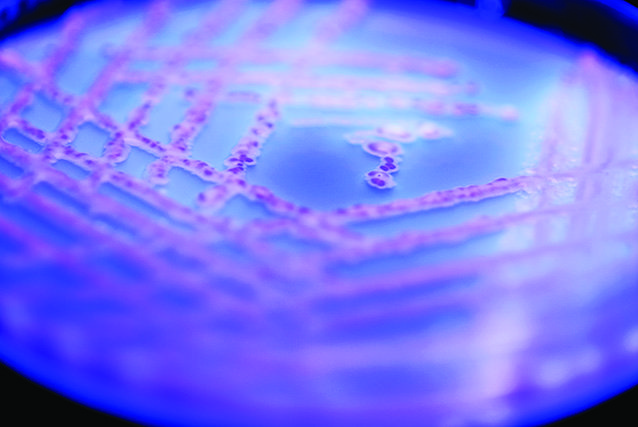
The Ability of Many Bacteria to Cause Disease is Genetically Regulated
‘Many bacteria that cause disease only produce the factors they need for this when they are at the site of infection in their hosts,’ explains Professor Robins-Browne. Bacteria do this by sensing where they are in the body and then activating the genes they require to colonise the site of infection and produce the factors they use to cause disease. This process of specific gene activation often involves bacterial proteins – called transcriptional regulators – that bind to DNA in order to activate relevant genes. If this process can be stopped (Professor Robins-Browne describes this as ‘disarming virulence’), the bacteria will remain harmless.
‘Advantages of this type of approach to treatment compared with traditional antibiotic therapy are that (1) unlike all current antibiotics, this process does not interfere with bacterial growth, and therefore is far less likely to lead to resistance, and (2) this type of treatment does not affect the harmless, commensal, “good” bacteria in our bodies, and therefore should have few side effects,’ says Professor Robins-Browne.
Citrobacter rodentium as a Model for E. coli Virulence
Established members of the attaching and effacing (A/E) family of pathogens responsible for human disease include enteropathogenic E. coli (EPEC) and enterohaemorrhagic E. coli (EHEC). EPEC commonly causes infections in infants, resulting in life-threatening diarrhoea, while EHEC is less common, but can cause serious foodborne outbreaks of bloody diarrhoea and the potentially fatal, haemolytic uraemic syndrome.
In order to evoke A/E lesions, bacteria need a particular suite of genes termed the locus of enterocyte effacement (LEE). This virulence factor allows bacteria to bind avidly to intestinal epithelial cells. Professor Robins-Browne and his colleagues used a mouse model of infection where a bacterial species, Citrobacter rodentium (C. rodentium), infects mouse gut epithelial cells in a fashion similar to that of EPEC/EHEC infection of humans. The research team aimed to identify novel colonisation factors of C. rodentium using a mutant library of C. rodentium in mice. Intriguingly, they discovered a particular gene that they called regA, which is very similar to perA of human EPEC and other genes encoding members of the AraC family of transcriptional regulators. These regulatory proteins facilitate the production of specific messenger RNA from a DNA template within cells – a process known as transcription. The transcription of DNA to produce messenger RNA is an essential step in the synthesis of all proteins, including enzymes and structural proteins that are essential for life.
Professor Robins-Browne and his team performed a series of experiments to elucidate the properties of regA. When the team deleted this gene in C. rodentium, they observed that the pathogen’s ability to colonise mouse intestines was greatly reduced. They also showed that the RegA protein strongly stimulates the transcription of several genes involved in virulence. Thus, the scientists demonstrated that RegA is an important virulence regulator in C. rodentium, and is similar to AraC-like virulence regulators in important human intestinal pathogens, such as EPEC, Salmonella, Shigella and cholera bacillus. Having identified this key virulence regulator, further studies were required to determine if its action could be inhibited by drug-like chemicals.
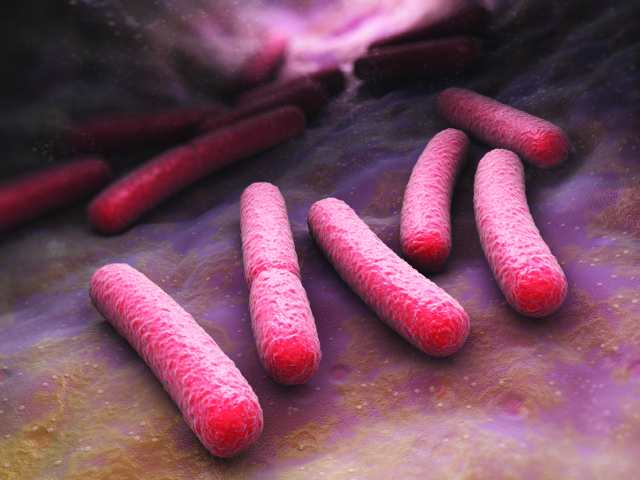
Regacin – a Prototypical Inhibitor of Virulence
Because the expression of virulence by many intestinal pathogens is tightly regulated at the transcriptional level, Professor Robins-Browne and his colleagues decided to focus on a strategy to target pathogens with drugs that interfere with virulence activation. Many Gram-negative intestinal pathogens including E. coli, Salmonella, Shigella, Yersinia and Vibrio cholerae, require virulence activators, equivalent to RegA, to cause disease.
Professor Robins-Browne and his team investigated the C. rodentium virulence regulator, RegA – the regulatory protein encoded by the regA gene – to see if it could be a potential drug target. By searching through a library of small molecules and using chemical optimisation, they were able to identify two small molecules that specifically prevented RegA from activating its target genes in C. rodentium, consequently reducing the expression of several genes required for virulence. These include a gene for another transcriptional regulator that is required to activate genes of the LEE.
In addition to this ground-breaking work, the team performed biophysical, biochemical, genetic and computational analyses, which showed that the inhibitors of RegA act by binding directly to RegA in a way that prevents it from binding to its DNA targets. They named the more potent of these compounds: ‘regacin’. When mice were fed regacin, either 15 minutes before or up to 12 hours after orally infecting them with C. rodentium, the team noticed a dramatic reduction in the numbers of this bacterium in the intestines of the mice. These findings demonstrated that chemically inhibiting RegA’s ability to bind to DNA is a viable strategy towards the development of drugs that inhibit virulence regulation.

Discovering a CfaD Inhibitor in E. coli
A challenge for Professor Robins-Browne and his team was to translate their work with C. rodentium to relevant pathogens of humans. Enterotoxigenic E. coli (ETEC) is one of the most common causes of infectious diarrhoea in children who live in developing countries, and is also notable for its ability to cause traveller’s diarrhoea. Traveller’s diarrhoea is a common problem, affecting millions of tourists each year, thus creating a large economic burden.
To cause disease, ETEC must first colonise the human gut epithelium. Once it does this, it delivers one or more toxins to the cells. CfaD is an AraC-like transcriptional regulator of ETEC, which plays an essential role in virulence gene expression in these bacteria. Might this mechanism be similar to that observed in earlier studies by Professor Robins-Browne and colleagues in their mouse model of infection?
The team analysed an ETEC strain that was grown under different conditions and found a set of genes that were regulated by CfaD. The team characterised a number of these genes, and were able to figure out how CfaD mediates their activation. They found that the expression of a cluster of known virulence genes, called the etpBAC operon, was activated by CfaD. This highlighted the importance of CfaD in inducing the production of a variety of surface molecules (called adhesins) that help bacteria bind to cells, thus allowing ETEC to colonise its host, and avoid being washed away by intestinal fluids and gut motility.
Finally, the team searched through a commercial small molecule library and found a molecule, they called CH-1, that specifically disrupts the regulatory function of CfaD. They then went on to discover a second compound, called CH-2, which had greater potency. The critical importance of CfaD in the control of ETEC virulence suggests that this has great potential as an authentic target for new types of drugs to combat ETEC infections.
A New Class of Antibiotics?
Many scientists now fear that mankind is standing on the precipice of an antibiotic doomsday scenario. However, Professor Robins-Browne’s team’s research has identified mechanisms through which bacterial virulence can be switched on, providing hope that these key molecular pathways may be targeted by future drugs.
The translational nature of the research activities of Professor Robins-Browne and colleagues is exemplified by their development of Travelan®, a commercial product that uses antibodies from cattle to prevent traveller’s diarrhoea. Now, by employing an ingenious molecular strategy, his team has shown that it is possible to subvert previously successful pathogenic mechanisms that result in significant morbidity.
Meet the researcher

Professor Roy Michael Robins-Browne
Department of Microbiology and Immunology
The University of Melbourne
Victoria
Australia
Professor Roy Robins-Browne was awarded his medical degree and PhD by the University of the Witwatersrand in South Africa. In 1982, he joined the Department of Microbiology at the University of Melbourne, Australia, as an Associate Professor. He went on to become a full Professor in 1996, and between 1998 and 2013, was Head or Deputy Head of the Department. In addition to his post at the University of Melbourne, he is also currently the co-leader of the Infectious Diseases and Microbiology Group at the Murdoch Childrens Research Institute at the Royal Children’s Hospital in Melbourne. The main focus of Professor Robins-Browne’s research is the pathogenesis of bacterial infections of the gastrointestinal tract, with a particular focus on E. coli. He has authored or co-authored more than 300 peer-reviewed papers on this and other topics concerning bacterial pathogens. He has also developed a commercial product for the prevention of traveller’s diarrhoea. Apart from his research, Professor Robins-Browne has played a central role in coordinating microbiology teaching for medical, biomedical and science students at University of Melbourne.
CONTACT
E: r.browne@unimelb.edu.au
T: (+61) 3 8344 8275
W: http://www.doherty.edu.au/people/professor-roy-robins-browne
KEY COLLABORATORS
Dr Ji Yang, Peter Doherty Institute, The University of Melbourne
Dr Marija Tauschek, Peter Doherty Institute, The University of Melbourne
Professor Michael Parker, St. Vincent’s Institute of Medical Research, and Bio21 Molecular Science and Biotechnology Institute, The University of Melbourne
Dr Jessica Holien, St. Vincent’s Institute of Medical Research
FUNDING
Australian National Health and Medical Research Council (NHMRC)
REFERENCES
C Hodson, J Yang, DH Hocking, K Azzopardi, Q Chen, JK Holien, MW Parker, M Tauschek, RM Robins-Browne, Control of virulence gene expression by the master regulator, CfaD, in the prototypical enterotoxigenic Escherichia coli strain, H10407, Frontiers in Microbiology, 2017, in press.
J Yang, DM Hocking, C Cheng, C Dogovski, MA Perugini, JK Holien, MW Parker, EL Hartland, M Tauschek, RM Robins-Browne, Disarming bacterial virulence through chemical inhibition of the DNA-binding domain of an AraC-like transcriptional activator protein, Journal of Biological Chemistry, 2013, 288, 31115–311126.
J Yang, M Tauschek, RM Robins-Browne, Control of bacterial virulence by AraC-like regulators that respond to chemical signals, Trends in Microbiology, 2011, 19, 128–135.
J Yang, C Dogovski, D Hocking, M Tauschek, M Perugini, RM Robins-Browne, Bicarbonate-mediated stimulation of RegA, the global virulence regulator from Citrobacter rodentium, Journal of Molecular Biology, 2009, 394, 591–599.
J Yang, E Hart, M Tauschek, GD Price, EL Hartland, RA Strugnell, RM Robins-Browne, Bicarbonate-mediated transcriptional activation of divergent operons by the virulence regulatory protein, RegA, from Citrobacter rodentium, Molecular Microbiology, 2008, 68, 314–327.
E Hart, J Yang, M Kelly, M Tauschek, MJ Wakefield, G Frankel, EL Hartland, RM Robins-Browne, RegA, an AraC-like protein, is a global transcriptional regulator that controls virulence gene expression in Citrobacter rodentium., Infectious Immunology, 2008, 76, 5247–5256.
